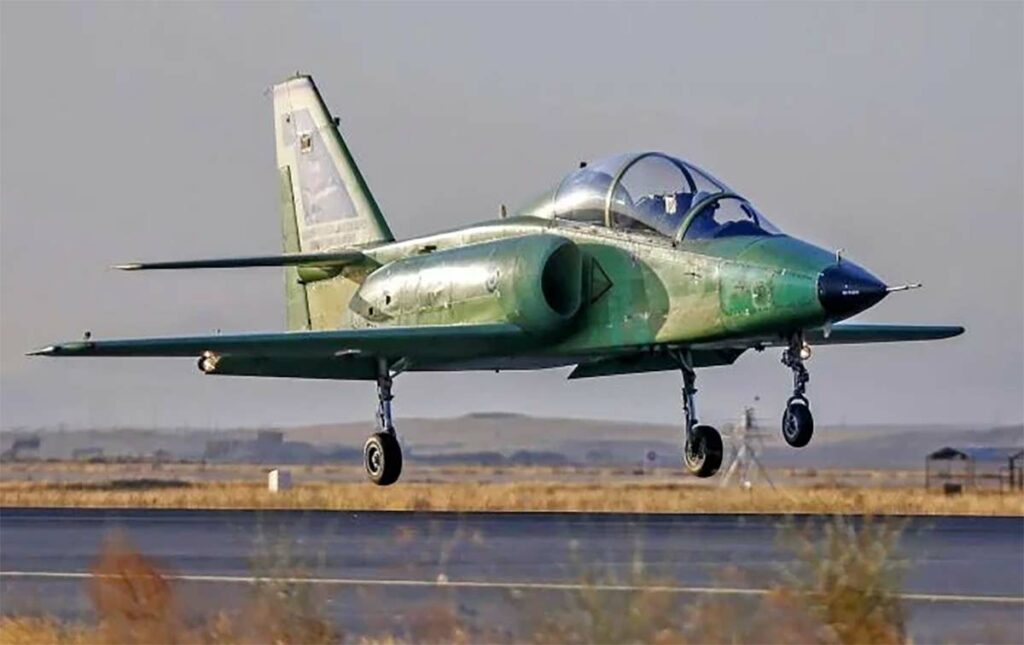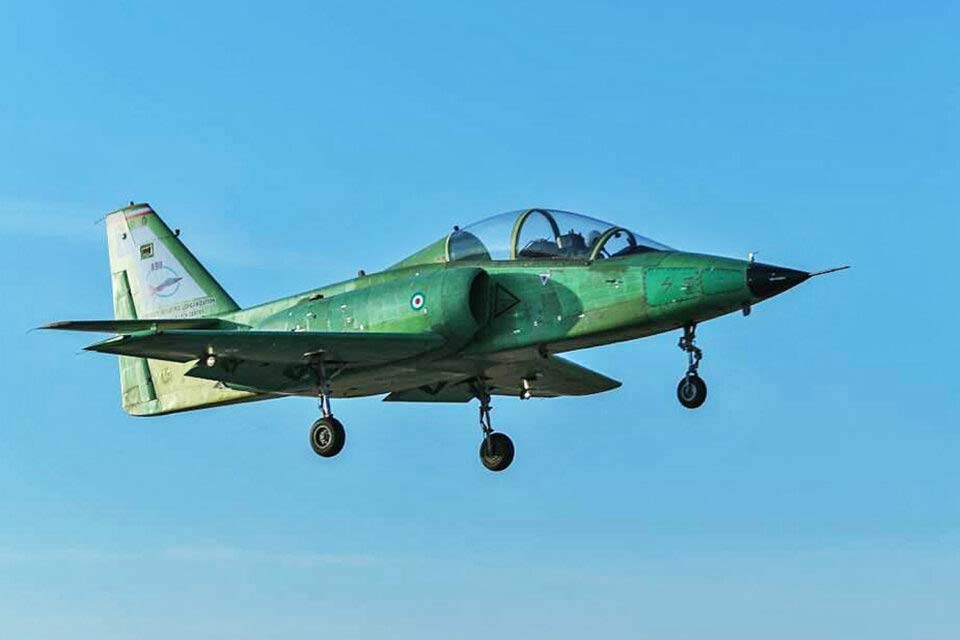The HESA Yasin is an Iranian twin-engine advanced jet trainer and light attack aircraft, featuring a length of 12.25 meters, wingspan of 10.4 meters, and powered by two Owj turbojet engines, each producing 3,600 pounds of thrust.
The HESA Yasin is an Iranian-developed advanced jet trainer and light attack aircraft, designed to enhance pilot training and provide close air support capabilities. Measuring 12.25 meters (40.2 feet) in length, with a wingspan of 10.4 meters (34.1 feet) and a height of 4 meters (13.1 feet), it has an empty weight of 3,900 kilograms (8,598 pounds) and a maximum takeoff weight of 5,500 kilograms (12,125 pounds). Powered by two Owj non-afterburning turbojet engines, each delivering 3,600 pounds (16 kilonewtons) of thrust, the Yasin achieves a maximum speed of 1,000 kilometers per hour (621 miles per hour) and a service ceiling of 11,000 meters (36,089 feet). Its operational range is 900 kilometers (559 miles), extendable to 1,200 kilometers (746 miles) with external fuel tanks. The aircraft features a tandem-seat configuration, modern avionics, and is equipped with five external hardpoints for various munitions, including gun pods, rocket pods, missiles, and bombs.
History of the Development of the HESA Yasin
In the late 20th and early 21st centuries, Iran faced significant challenges in maintaining and upgrading its aging fleet of military aircraft, primarily due to international sanctions limiting access to foreign technology and parts. This situation underscored the necessity for self-reliance in military aviation capabilities. The Iranian government, recognizing the critical need for an indigenous advanced jet trainer to prepare pilots for modern combat aircraft, initiated the development of the HESA Yasin.
The program was launched by the Iran Aviation Industries Organization (IAIO), with design and manufacturing responsibilities assigned to the Iran Aircraft Manufacturing Industries Corporation (HESA). The primary objective was to create an aircraft capable of providing advanced training to pilots transitioning to frontline fighters, thereby enhancing the overall effectiveness of the Iranian Air Force.
The Yasin project aimed to address several key requirements:
- Modern Training Capabilities: To equip pilots with the skills necessary to operate contemporary combat aircraft, incorporating advanced avionics and flight systems.
- Operational Flexibility: To serve not only as a trainer but also as a light attack aircraft capable of close air support missions.
- Indigenous Production: To reduce dependence on foreign suppliers by utilizing domestically produced components and systems.
The development process involved extensive collaboration between Iranian aerospace engineers and military experts. The design phase focused on creating an aircraft that balanced performance, ease of maintenance, and cost-effectiveness. Advanced computer-aided design tools were employed to optimize aerodynamics and structural integrity.
The Yasin was first unveiled to the public on October 17, 2019, during a ceremony at the Shahid Noje Airbase in Iran’s western province of Hamadan. This event marked a significant milestone, showcasing Iran’s commitment to advancing its aerospace industry despite external pressures.
The aircraft’s name, “Yasin,” holds cultural significance, as it is derived from a chapter in the Quran, reflecting the nation’s heritage and aspirations.
Following its unveiling, the Yasin underwent a series of ground and flight tests to validate its design and performance parameters. These tests aimed to assess various aspects, including flight stability, engine performance, avionics functionality, and weapons integration.
In March 2023, the second prototype of the Yasin was unveiled, featuring significant advancements over the initial version. This updated model incorporated improvements in avionics, ejection seats, engines, airborne weather radar, and landing gear, all developed by domestic knowledge-based companies. The production line for serial manufacturing of the Yasin was also inaugurated at this time, signaling Iran’s readiness to commence mass production.
The Yasin’s development reflects Iran’s strategic initiative to achieve self-sufficiency in military aviation. By investing in indigenous design and manufacturing capabilities, Iran aims to mitigate the impact of international sanctions and enhance its defense readiness.
The aircraft’s dual role as both a trainer and a light attack platform provides the Iranian Air Force with operational flexibility, allowing for efficient pilot training and the capability to conduct close air support missions as needed.
The Yasin’s development journey underscores the challenges and achievements of Iran’s aerospace industry. From its inception to the commencement of mass production, the program highlights the nation’s determination to advance its technological capabilities and maintain the operational readiness of its air force.

Design of the HESA Yasin
The HESA Yasin exhibits a design that aligns with contemporary advanced jet trainers, emphasizing aerodynamic efficiency, pilot visibility, and system integration.
Airframe and Dimensions:
- Length: 12.25 meters (40.2 feet)
- Wingspan: 10.4 meters (34.1 feet)
- Height: 4 meters (13.1 feet)
- Wing Area: 24 square meters (258.3 square feet)
The aircraft’s airframe is constructed using lightweight materials to optimize performance and fuel efficiency. The low-mounted wings with clipped tips and swept-back leading edges contribute to aerodynamic stability and maneuverability.
Fuselage and Cockpit Configuration:
- The Yasin features a tandem-seat cockpit, allowing for an instructor and trainee or a mission pilot and weapons systems officer in combat scenarios.
- The cockpit canopy is a bubble-style configuration, enhancing pilot visibility and reducing drag.
- It is equipped with ejection seats, designed for emergency escape at various altitudes and speeds.
Avionics and Flight Systems:
- The aircraft integrates a fully digital avionics suite, developed domestically, including multi-function displays (MFDs) and a heads-up display (HUD) for enhanced situational awareness.
- Fly-by-wire flight control systems contribute to increased precision and reduced pilot workload.
- A mission computer and onboard radar system enable weapons targeting and navigation.
Engines and Powerplant:
- The aircraft is powered by two Owj turbojet engines, each producing 3,600 pounds (16 kN) of thrust.
- These engines are Iranian-made derivatives of the General Electric J85, adapted for domestic production.
- The Yasin lacks an afterburner, focusing on fuel efficiency and sustained performance at subsonic speeds.
Landing Gear and Structural Features:
- Tricycle landing gear with reinforced struts enables operation from both paved and semi-prepared runways.
- The main gear is retractable, reducing drag and improving aerodynamics.
- The nose gear is designed with a twin-wheel system, improving ground handling and stability during takeoff and landing.
Weapons and External Stores:
- The Yasin has five hardpoints, one under the fuselage and two under each wing.
- It can carry gun pods, unguided rockets, precision-guided munitions, and air-to-ground missiles.
- It is also capable of mounting external fuel tanks, extending its operational range.
Design Advantages and Limitations:
- Advantages:
- Fully indigenous production minimizes reliance on foreign components.
- Multi-role capability enhances operational flexibility.
- Modern avionics and digital flight systems improve training quality.
- Limitations:
- Subsonic performance limits its capability against high-speed adversaries.
- Lack of advanced radar systems restricts engagement range in air-to-air combat.
- Payload capacity is limited compared to dedicated attack aircraft.
Performance of the HESA Yasin
Speed and Maneuverability:
- Maximum Speed: 1,000 km/h (621 mph)
- Cruise Speed: Estimated at 850 km/h (528 mph)
- Stall Speed: Approximately 180 km/h (112 mph)
The Yasin’s speed places it in the subsonic category, similar to other advanced jet trainers like the Hongdu L-15 and Yakovlev Yak-130. While not designed for air superiority, its agility and avionics compensate for speed limitations.
Altitude and Climb Rate:
- Service Ceiling: 11,000 meters (36,089 feet)
- Rate of Climb: Estimated at 40 m/s (7,874 feet per minute)
With an operational ceiling of 11,000 meters, the aircraft can conduct training and attack missions at medium altitudes, allowing flexibility in mission planning.
Range and Endurance:
- Operational Range: 900 km (559 miles)
- Extended Range (with external tanks): 1,200 km (746 miles)
- Endurance: Estimated at 2 to 3 hours
This range is sufficient for training and close air support missions, but it remains limited for extended operations without aerial refueling capabilities.
Comparison to Competitors:
- Compared to the KAI T-50 Golden Eagle, the Yasin has inferior speed and avionics but is more cost-effective.
- Against the Aero L-39 Albatros, the Yasin has a similar speed but benefits from modernized systems.
- The Yakovlev Yak-130 offers superior performance due to its higher thrust engines and advanced weapons integration.
Powerplant and Thrust-to-Weight Ratio:
- The twin Owj engines provide a total thrust of 7,200 pounds (32 kN).
- With a maximum takeoff weight of 5,500 kg (12,125 lbs), the thrust-to-weight ratio is approximately 0.58, making it adequate for training but not optimized for high-performance combat.

Variants of the HESA Yasin
- Yasin-1 (Initial Prototype)
- Featured basic avionics and engine integration.
- Primarily used for early flight testing and aerodynamic evaluation.
- Yasin-2 (Improved Version, 2023)
- Integrated modernized avionics and digital cockpit systems.
- Stronger landing gear for operations on various airfields.
- Enhanced radar and weapons capabilities for light attack missions.
- Yasin Combat Variant (Planned Version)
- Designed to serve as a dedicated light attack aircraft.
- Expected to integrate advanced targeting pods and improved munitions compatibility.
- Still in the early conceptual stage, with no official production timeline.
Military Use and Combat of the HESA Yasin
Armament and Weaponry:
- Five hardpoints allow for multiple weapon configurations.
- Air-to-Ground Missiles: Compatibility with Sadid-345 and Qadr series guided missiles.
- Bombs: Capability to carry Mk-82 free-fall bombs and precision-guided bombs.
- Gun Pods: Optional 20mm or 23mm gun pods for strafing missions.
- Rocket Pods: Can mount 70mm unguided rocket launchers for close air support.
Operational History and Combat Usage:
- The Yasin is not yet confirmed to have participated in active combat.
- It is expected to be integrated into the Iranian Air Force’s pilot training pipeline.
- Given its light attack capability, it may be used for border security operations and counterinsurgency missions.
Potential Sales and Export Prospects:
- No confirmed foreign sales at this time.
- Iran may offer the aircraft to allied nations under embargo restrictions.
- Possible interest from countries seeking low-cost training and light attack solutions.
Current and Future Status:
- The Yasin is currently undergoing further testing and refinement.
- Iran has announced plans for full-scale production, with mass delivery expected in the coming years.
- The aircraft is expected to complement Iran’s existing fleet of MiG-29s, Su-24s, and indigenous Kowsar aircraft.
The HESA Yasin represents Iran’s strategic initiative to develop an indigenous advanced jet trainer and light attack aircraft. While it lacks the speed and technological sophistication of Western or Russian equivalents, its low-cost design and multi-role capability make it an asset for Iran’s defense sector. The Yasin’s tandem-seat configuration, modern avionics, and flexible weapons integration provide essential training capabilities for Iranian pilots transitioning to front-line fighters. Despite its limitations in range and combat capabilities, the Yasin marks a significant step toward self-sufficiency in Iran’s military aviation industry.
Back to the Trainers section.